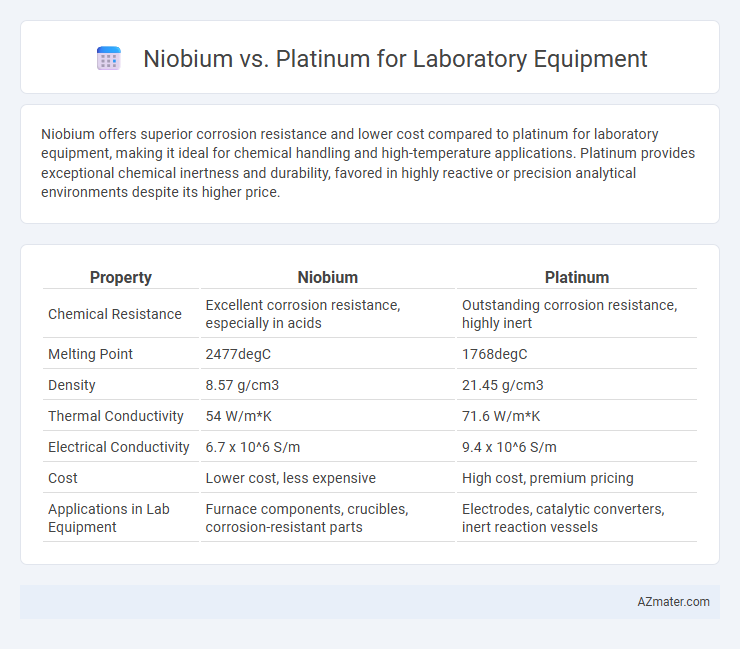Niobium offers superior corrosion resistance and lower cost compared to platinum for laboratory equipment, making it ideal for chemical handling and high-temperature applications. Platinum provides exceptional chemical inertness and durability, favored in highly reactive or precision analytical environments despite its higher price.
Table of Comparison
| Property | Niobium | Platinum |
|---|---|---|
| Chemical Resistance | Excellent corrosion resistance, especially in acids | Outstanding corrosion resistance, highly inert |
| Melting Point | 2477degC | 1768degC |
| Density | 8.57 g/cm3 | 21.45 g/cm3 |
| Thermal Conductivity | 54 W/m*K | 71.6 W/m*K |
| Electrical Conductivity | 6.7 x 10^6 S/m | 9.4 x 10^6 S/m |
| Cost | Lower cost, less expensive | High cost, premium pricing |
| Applications in Lab Equipment | Furnace components, crucibles, corrosion-resistant parts | Electrodes, catalytic converters, inert reaction vessels |
Introduction: Niobium vs Platinum in Laboratory Applications
Niobium and platinum are both valued materials in laboratory equipment due to their unique chemical and physical properties. Niobium offers exceptional corrosion resistance and a high melting point, making it ideal for handling aggressive chemicals and high-temperature reactions. Platinum, renowned for its excellent catalytic properties and resistance to oxidation, remains a standard choice for precision instruments and electrodes in analytical applications.
Chemical Properties: Reactivity and Resistance
Niobium exhibits exceptional chemical resistance due to its stable oxide layer, making it highly resistant to corrosion and oxidation in acidic and oxidizing environments often encountered in laboratory settings. Platinum also offers excellent chemical inertness, maintaining stability even in harsh conditions such as strong acids and high temperatures, but is more susceptible to dissolution in aqua regia and halogenated solvents. The choice between niobium and platinum for laboratory equipment depends on specific chemical exposure, with niobium favored for environments requiring resistance to oxidation and platinum preferred for applications demanding maximal chemical inertness and thermal stability.
Thermal Stability and Heat Tolerance
Niobium exhibits superior thermal stability with a melting point of 2,468degC, making it highly suitable for laboratory equipment exposed to extreme heat. Platinum, while also thermally stable with a melting point of 1,768degC, offers excellent corrosion resistance in high-temperature acidic environments. Niobium's exceptional heat tolerance and resistance to oxidation provide an advantage in applications requiring sustained high-temperature exposure without material degradation.
Mechanical Strength and Durability
Niobium exhibits high mechanical strength with excellent resistance to deformation, making it ideal for laboratory equipment subjected to stress and heavy use. Platinum, while valuable for its chemical inertness, has lower tensile strength and is more prone to wear and surface damage under mechanical strain. Niobium's superior durability extends equipment lifespan, reducing maintenance costs and ensuring consistent performance in demanding experimental environments.
Corrosion Resistance in Laboratory Environments
Niobium exhibits exceptional corrosion resistance in highly acidic and oxidizing laboratory environments, making it ideal for handling aggressive chemicals that can degrade other metals. Platinum, known for its outstanding inertness, resists corrosion even at elevated temperatures and in harsh chemical reactions, ensuring durability in precise analytical procedures. Both metals maintain structural integrity in corrosive conditions, but niobium is often preferred for cost-effective applications requiring strong acid resistance, while platinum excels in high-purity, high-stress laboratory equipment.
Cost Comparison and Economic Considerations
Niobium offers a significantly lower cost compared to platinum, with prices approximately 70-80% less per ounce, making it an economically attractive choice for laboratory equipment requiring corrosion resistance and high-temperature durability. While platinum's superior chemical inertness and established supply chain provide long-term reliability, its high market price and volatility increase total ownership costs. Many laboratories balance initial expenses and maintenance budgets by opting for niobium components when cost efficiency without sacrificing essential performance is a priority.
Suitability for High-Temperature Processes
Niobium offers superior resistance to high temperatures, making it ideal for laboratory equipment used in extreme thermal environments. Its melting point of 2,468degC significantly exceeds platinum's 1,768degC, ensuring better structural integrity during high-temperature processes. Platinum, while corrosion-resistant, may deform or lose strength in applications exceeding its melting threshold, limiting its effectiveness in ultra-high-temperature experiments.
Compatibility with Laboratory Chemicals and Acids
Niobium exhibits exceptional resistance to a wide range of laboratory chemicals and acids, including strong oxidizing agents like nitric acid and hydrochloric acid, making it highly suitable for corrosive environments. Platinum also offers superior chemical inertness and withstands aggressive acids such as aqua regia and sulfuric acid, but its higher cost limits widespread use. The choice between niobium and platinum depends on specific chemical exposure, with niobium favored for cost-effective corrosion resistance and platinum preferred for extreme chemical stability under harsh experimental conditions.
Availability and Sourcing of Niobium and Platinum
Niobium is moderately abundant in the Earth's crust, primarily sourced from countries like Brazil and Canada, making it relatively accessible for laboratory equipment production. Platinum is much rarer, predominantly mined in South Africa, Russia, and Zimbabwe, resulting in higher costs and supply constraints. The scarcity and complex extraction processes of platinum often lead to supply volatility, whereas niobium benefits from more stable availability and sourcing logistics.
Choosing the Right Metal for Specific Laboratory Equipment
Niobium offers exceptional corrosion resistance and high melting points, making it ideal for laboratory equipment exposed to harsh chemicals and extreme temperatures. Platinum, prized for its unparalleled chemical inertness and electrical conductivity, is preferred for precision instruments and catalytic applications. Selecting between niobium and platinum depends on the specific laboratory environment, with niobium favored for durability and cost-effectiveness, while platinum excels in performance-critical roles requiring superior chemical stability.

Infographic: Niobium vs Platinum for Laboratory Equipment
 azmater.com
azmater.com